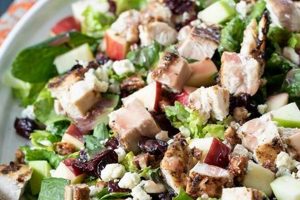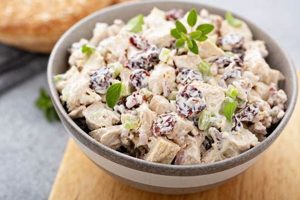A combination of cooked chicken, mayonnaise, and often celery, onion, and seasonings forms the foundation of this classic dish. The addition of sweet grapes and crunchy almonds provides textural and flavor complexity, elevating the salad beyond a simple combination of ingredients. Variations might include different types of grapes (red, green, or black) and almonds (slivered, sliced, or whole), as well as other additions such as dried cranberries, apples, or walnuts.
This specific blend of ingredients offers a balance of sweet, savory, and crunchy elements. The grapes contribute a juicy sweetness that complements the savory chicken and creamy mayonnaise. Almonds provide a satisfying crunch and a subtle nutty flavor, enhancing the overall sensory experience. This combination has become a popular choice for sandwiches, wraps, salads, or as a standalone appetizer. The historical context likely stems from the evolution of chicken salad recipes, with cooks experimenting with different fruits and nuts to enhance the flavor and texture.
Further exploration of this culinary combination could involve analyzing different recipe variations, discussing the nutritional benefits of each ingredient, and providing tips for optimal preparation and presentation. One might also consider the cultural significance of chicken salad and its place within various culinary traditions.
Tips for Preparing Chicken Salad with Grapes and Almonds
Optimizing the preparation of this dish involves careful consideration of ingredient selection and combination for maximum flavor and texture.
Tip 1: Poaching Chicken for Enhanced Flavor: Poaching chicken breasts results in tender, flavorful meat ideal for salad. Season the poaching liquid with herbs and aromatics for added depth.
Tip 2: Selecting Grapes: Seedless grapes, whether red or green, offer convenience. Consider the sweetness level and texture; firmer grapes hold their shape better.
Tip 3: Toasting Almonds: Toasting almonds enhances their nutty flavor and adds a desirable crunch. Toast them lightly in a dry pan or oven until fragrant.
Tip 4: Balancing Flavors: Achieve balance by using a good quality mayonnaise and adding complementary seasonings like Dijon mustard, celery salt, and freshly ground black pepper.
Tip 5: Mayonnaise Alternatives: For a lighter version, consider using Greek yogurt, plain yogurt, or a combination of mayonnaise and yogurt.
Tip 6: Ingredient Ratios: The ratio of chicken, grapes, and almonds can be adjusted based on personal preference. Start with equal proportions and adjust according to taste.
Tip 7: Chilling for Optimal Flavor: Chilling the salad for at least 30 minutes allows the flavors to meld and enhances the overall experience.
Following these tips ensures a well-balanced and flavorful salad with optimal texture and taste. Attention to detail in each step, from ingredient selection to chilling time, contributes significantly to the final product.
By understanding the nuances of preparation, one can consistently create a delicious and satisfying dish.
1. Chicken (cooked, diced)
Cooked, diced chicken forms the foundational protein component of chicken salad incorporating grapes and almonds. Its preparation and characteristics significantly influence the final dish’s overall quality and flavor profile.
- Cooking Method Impact
The cooking method employed directly affects the chicken’s texture and taste. Poaching yields moist, tender results ideal for salad, while grilling or roasting imparts smokier nuances. Boiling can result in drier meat, impacting the final salad’s consistency. Choosing the appropriate cooking method is crucial for optimizing the salad’s texture and flavor.
- Dicing Consistency
Uniform dicing ensures even distribution throughout the salad and contributes to a pleasant mouthfeel. Overly large pieces can disrupt the balance, while excessively small pieces might result in a mushy texture. Consistent dicing promotes both visual appeal and balanced flavor distribution.
- Chicken Type Considerations
Different chicken types, such as breast, thigh, or a combination, influence the salad’s flavor and richness. Chicken breast offers a leaner option, while thigh meat contributes more moisture and a richer taste. Selection depends on desired flavor profile and dietary preferences.
- Seasoning During Cooking
Seasoning the chicken during the cooking process, as opposed to solely seasoning the final salad, infuses the meat with deeper flavor. Incorporating herbs, spices, or aromatics during cooking enhances the overall complexity of the chicken salad. This pre-emptive seasoning elevates the chicken’s flavor profile, contributing significantly to the final dish.
These facets of chicken preparation highlight its integral role in the chicken salad recipe with grapes and almonds. Careful consideration of cooking method, dicing consistency, chicken type, and pre-emptive seasoning significantly influence the final product’s taste, texture, and overall quality. The chosen approach to preparing the chicken sets the stage for the successful integration of other ingredients and the achievement of a well-balanced, flavorful salad.
2. Mayonnaise (quality binder)
Mayonnaise serves as the unifying element in chicken salad with grapes and almonds, binding the diverse ingredients into a cohesive whole. Its quality and characteristics significantly influence the final product’s texture, flavor, and overall palatability. Understanding mayonnaise’s role goes beyond simply using it as a condiment; it’s about recognizing its contribution to the salad’s structural integrity and sensory experience.
- Emulsification and Texture
Mayonnaise, an emulsion of oil and egg yolks, provides the creamy texture characteristic of chicken salad. A stable emulsion prevents separation and ensures a smooth, consistent mouthfeel. High-quality mayonnaise, with its stable emulsification, contributes significantly to the salad’s desirable texture, preventing a watery or greasy consistency.
- Flavor Enhancement and Balance
Beyond texture, mayonnaise contributes a subtle tanginess and richness that complements the other ingredients. Its flavor profile enhances the savory notes of the chicken and balances the sweetness of the grapes. The right mayonnaise enhances, rather than overpowers, the other flavors, contributing to a harmonious blend.
- Ingredient Compatibility and Binding
Mayonnaise acts as an adhesive, binding the chicken, grapes, almonds, and other ingredients together. Its consistency allows for even distribution of flavors and ensures that the salad holds its shape. This binding quality is essential for the structural integrity of the salad, preventing it from becoming a disjointed mix of ingredients.
- Mayonnaise Variations and Flavor Profiles
Different types of mayonnaise, such as those made with olive oil, avocado oil, or flavored with herbs and spices, offer diverse flavor profiles that can be tailored to complement the salad’s ingredients. Choosing a mayonnaise that complements the other flavors allows for customization and elevates the overall culinary experience. For example, a lemon-infused mayonnaise could accentuate the brightness of the grapes.
The selection and utilization of mayonnaise significantly impact the final quality of chicken salad with grapes and almonds. Its role extends beyond simply binding ingredients together; it contributes to the texture, flavor balance, and overall sensory experience. Choosing a high-quality mayonnaise and understanding its properties is essential for creating a truly exceptional chicken salad.
3. Grapes (sweetness, texture)
Grapes contribute a crucial dimension of sweetness and textural contrast within a chicken salad incorporating almonds. This seemingly simple addition significantly impacts the overall sensory experience, elevating the dish beyond a basic protein-and-fat combination. The inherent sweetness of grapes counterbalances the savory elements of the chicken and mayonnaise, creating a more complex and nuanced flavor profile. Furthermore, the grapes’ juicy burst and slightly firm texture provide a pleasant contrast to the creamy mayonnaise and crunchy almonds. This interplay of textures creates a dynamic mouthfeel that enhances enjoyment.
Consider, for example, a chicken salad made solely with chicken, mayonnaise, and almonds. While palatable, it might lack vibrancy and depth. The introduction of grapes immediately brightens the flavor profile, adding a refreshing sweetness that cuts through the richness of the mayonnaise. The textural contrast provided by the grapes further elevates the dish, transforming it from a homogenous mixture into a multi-faceted culinary experience. One can observe this effect in various recipes: a classic chicken salad sandwich benefits from the added sweetness and juiciness of grapes, while a composed salad featuring chicken, grapes, almonds, and mixed greens gains a delightful interplay of textures and flavors.
Understanding the dual contribution of grapessweetness and textureis crucial for optimizing chicken salad recipes that include almonds. Balancing these elements allows for a harmonious blend of flavors and textures, resulting in a more satisfying and enjoyable culinary creation. Failure to consider the grape’s role can lead to an unbalanced dish, either too sweet or lacking textural diversity. This understanding allows for informed decisions regarding grape variety selection, quantity, and preparation methods, ultimately leading to a more refined and delicious final product.
4. Almonds (crunch, flavor)
Almonds contribute a critical textural and flavor dimension to chicken salad incorporating grapes. Their presence elevates the dish beyond a simple combination of ingredients, providing a satisfying crunch that contrasts with the softer textures of the chicken and grapes. This textural complexity enhances the overall sensory experience, making each bite more engaging. Furthermore, almonds impart a subtle, nutty flavor that complements the savory chicken and sweet grapes, creating a more nuanced and balanced flavor profile. This interplay of textures and flavors distinguishes this specific type of chicken salad from variations that lack the distinct crunch and subtle nuttiness of almonds.
The importance of almonds as a component becomes evident when comparing versions with and without them. A chicken salad lacking almonds might feel texturally monotonous, dominated by the soft textures of chicken and mayonnaise. The absence of the almond’s characteristic crunch diminishes the sensory experience. Similarly, the flavor profile might lack depth, missing the subtle nuttiness that almonds provide. For instance, consider a chicken salad sandwich. The addition of almonds elevates the sandwich by adding a satisfying crunch that contrasts with the soft bread and creamy filling. The almond’s flavor also complements other ingredients, such as lettuce and tomato, creating a more complex and enjoyable flavor profile.
Understanding the role of almondsproviding both crunch and flavoris crucial for optimizing the overall quality of this specific type of chicken salad. Careful consideration of almond type (slivered, sliced, or whole), quantity, and preparation (toasted or raw) allows for customization and control over the final product’s textural and flavor profile. This knowledge empowers culinary practitioners to create a more balanced and satisfying dish, ensuring a harmonious blend of textures and flavors that elevates the dining experience. Ignoring the almond’s dual contribution can result in a less dynamic and flavorful salad, missing the hallmark crunch and subtle nuttiness that define this variation.
5. Seasoning (balance, depth)
Seasoning plays a crucial role in the overall success of a chicken salad recipe that incorporates grapes and almonds. It provides the balancing touch that elevates the dish from a simple combination of ingredients to a harmonious blend of flavors. Careful seasoning enhances the inherent flavors of the chicken, grapes, and almonds, while also adding depth and complexity. Understanding the nuances of seasoning allows for precise control over the final product’s flavor profile, ensuring a well-balanced and satisfying culinary experience.
- Salt’s Foundational Role
Salt acts as the cornerstone of seasoning, enhancing the natural flavors of all ingredients. It amplifies the savory notes of the chicken, balances the sweetness of the grapes, and rounds out the nuttiness of the almonds. The correct amount of salt is essential for a well-rounded flavor profile. Too little salt can result in a bland dish, while too much can overpower the delicate balance of flavors.
- Acidity’s Balancing Influence
Acidity, often introduced through lemon juice or vinegar, provides a crucial counterpoint to the richness of the mayonnaise and the sweetness of the grapes. A touch of acidity brightens the overall flavor profile, preventing the salad from becoming overly heavy or sweet. This balance is essential for a refreshing and palatable dish. For example, a squeeze of fresh lemon juice can add a vibrant note that enhances the other flavors without dominating them.
- Aromatic Herbs and Spices
Fresh or dried herbs and spices introduce layers of complexity to the flavor profile. Fresh dill, parsley, or chives add a bright, herbaceous note, while a pinch of black pepper provides a subtle warmth. The judicious use of aromatics can significantly elevate the overall sensory experience, adding depth and intrigue to each bite. For example, a touch of tarragon can impart a unique anise-like flavor that complements the other ingredients.
- Balancing Sweetness and Savory Notes
Achieving a harmonious balance between sweetness and savory notes is essential for a successful chicken salad. The inherent sweetness of the grapes must be balanced by the savory chicken and the subtle tang of the mayonnaise. Seasoning adjustments, such as a touch of Dijon mustard or a pinch of celery salt, can further enhance this balance, creating a more complex and satisfying flavor profile. This careful balancing act ensures that no single flavor dominates, resulting in a harmonious blend.
The interplay of these seasoning elements is crucial for maximizing the flavor potential of a chicken salad recipe with grapes and almonds. A well-seasoned salad exhibits a balance of sweet, savory, and acidic notes, complemented by the subtle complexities of herbs and spices. This attention to seasoning detail elevates the dish from a simple combination of ingredients to a carefully crafted culinary creation, demonstrating the transformative power of thoughtful seasoning in achieving a truly exceptional final product.
Frequently Asked Questions
This section addresses common inquiries regarding the preparation and enjoyment of chicken salad featuring grapes and almonds. Clarity on these points ensures optimal results and addresses potential concerns.
Question 1: What type of grapes is best suited for this recipe?
Seedless varieties, both red and green, offer convenience and a pleasant texture. The choice depends on personal preference and desired sweetness level.
Question 2: Can other nuts be substituted for almonds?
Walnuts, pecans, or cashews can be substituted, though they will impart different flavor profiles and textural nuances. Consider the overall balance of flavors when making substitutions.
Question 3: How long can this chicken salad be stored in the refrigerator?
Properly stored in an airtight container, it should be consumed within three to four days to maintain optimal quality and safety.
Question 4: What are some suitable serving suggestions beyond sandwiches?
This salad serves well as a filling for lettuce wraps, a topping for crackers or crostini, or as a component within a larger composed salad featuring mixed greens and other vegetables.
Question 5: How can one adjust the recipe to accommodate dietary restrictions, such as gluten-free or lower fat?
Gluten-free bread or crackers can be used for sandwiches. For a lower-fat version, consider using Greek yogurt, plain yogurt, or a combination of mayonnaise and yogurt as a substitute for full-fat mayonnaise. Adjusting the quantity of almonds can also modify the fat content.
Question 6: Can the chicken be prepared in advance?
Cooking and dicing the chicken ahead of time streamlines the salad assembly process. Store cooked chicken properly in the refrigerator and incorporate it into the salad when ready.
Understanding these frequently asked questions facilitates a smoother preparation process and addresses potential uncertainties, ensuring an enjoyable culinary experience. This information empowers individuals to tailor the recipe to their specific preferences and dietary needs.
Further exploration might involve detailed recipe variations, nutritional information, or cultural context related to this classic dish. The possibilities are vast and offer opportunities for deeper understanding and culinary exploration.
Chicken Salad Recipe Grapes Almonds
Exploration of this specific chicken salad variation reveals the synergistic relationship between core ingredients. Cooked chicken provides the foundational protein, complemented by the creamy texture and subtle tang of mayonnaise. Sweet, juicy grapes offer a textural and flavor counterpoint to the satisfying crunch and nutty depth of almonds. Careful seasoning, balancing salt, acidity, and aromatics, further enhances the interplay of these elements. The resulting dish offers a complex flavor profile and a delightful textural experience, demonstrating the culinary potential of thoughtfully combining readily available ingredients.
The enduring popularity of this combination speaks to its versatility and adaptability. Continued experimentation with ingredient variations, ratios, and complementary seasonings offers opportunities for personalized culinary expression. An understanding of the core principlesbalancing flavors, textures, and seasoningempowers culinary practitioners to create nuanced and satisfying variations on this classic dish, ensuring its continued presence in culinary traditions.






